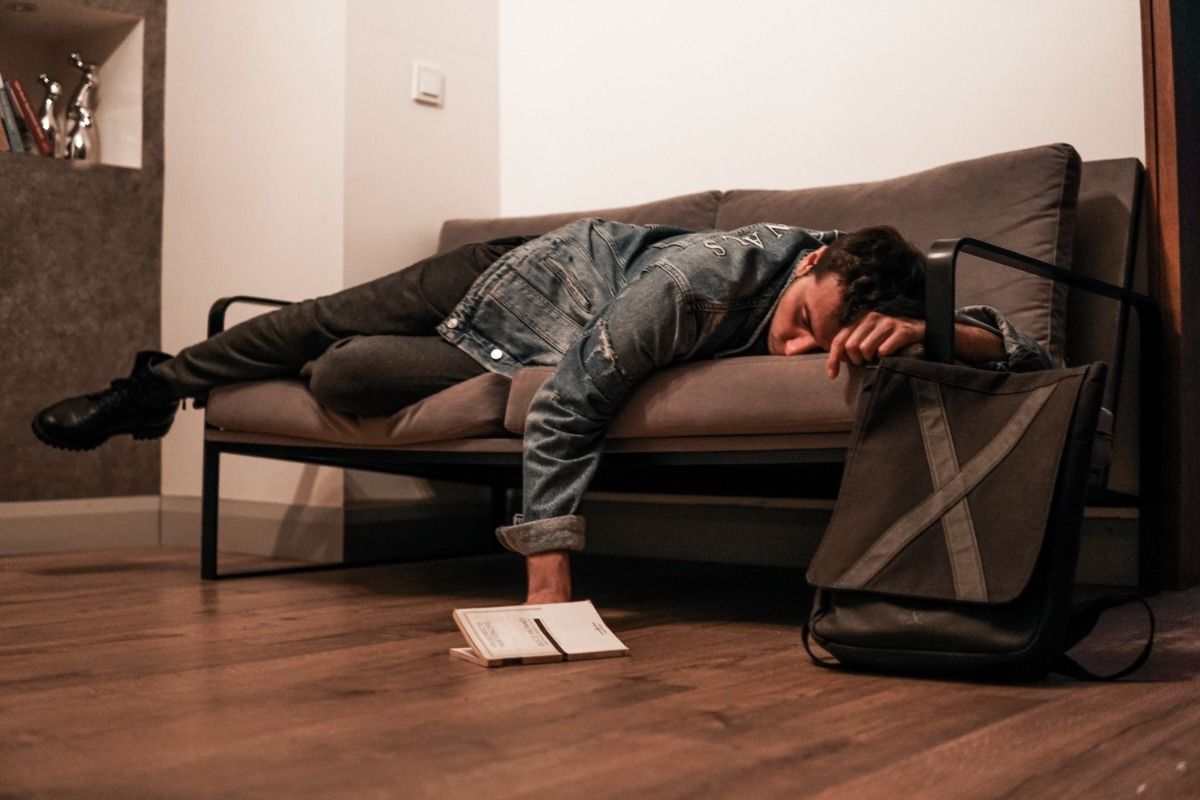
The healthiest sleeping position will be different for everyone. Someone with chronic back pain or neck pain will have to sleep in a different position than someone who has digestive issues or irritable bowel syndrome.
I’ll start off right away by confirming that sleeping on your stomach (stomach sleeping) is not the healthiest sleeping position for most people. In fact, it might be best known as the unhealthiest position. Stomach sleeping will put too much weight and pressure on your internal organs.
When it comes to the healthiest sleeping position, there will be different positions recommended for different people. To discuss this matter is simultaneously objective and subjective, and that’s complicated. See, individuals have different sleep position needs not only as they mature and develop, but in contrast to friends or family members.
In one family, perhaps the father sleeps on his back and snores like a Mack truck. His kids sleep on their sides. Meanwhile, his wife sleeps on her side. But the man who snores didn’t originally sleep on his back; he used to sleep in a fetal position until he quit exercising as much, and his body stiffened a little. This is an example of how many factors can come into play when it comes to what your best sleep position is.
Not only do sleep positions differ personally, but your body will in part dictate how you sleep. So your particular healthiest position to sleep in may differ from someone else’s. Neither of you are wrong, neither of you are right—because the issue isn’t your body’s position, it’s how much rest you get every night, and how you feel in the morning. In a big way, the healthiest sleep position for you is whatever position you can fall asleep in and stay asleep comfortably in.
Sometimes your position isn’t the issue or cause of your poor sleep. Sometimes, what you really need to do is switch up your sleeping arrangements. Instead of sleeping on the same old mattress and bedding that makes you sweat every night, you just need a cooling mattress to drift into dreamland. Other times, you may want to change up your sleeping position to get more comfortable. Below are some of the healthiest sleeping positions:
Left Side Sleepers
Left-side sleeping has many science-backed health benefits. The organ placement of the human body makes us asymmetrical internally. Our sleep position as a left-side sleeper can improve gut health and improve the way we direct and process waste
Those living with irritable bowel syndrome, constipation, inflammatory bowel disease, or other gastrointestinal conditions may find relief through regularly sleeping on their left side.
While you sleep on your left side, gravity can help move waste through the ascending colon while you sleep, then into the transverse colon, and finally waste makes its way into the descending colon. You could therefore wake up with a very healthy bowel movement.

Side Sleeping for Back Pain
Regular side sleeping is very similar to the fetal position, but your legs seem to be stretched out a little more, and your torso isn’t as crunched in. With side-sleeping, you can relieve your back. Also, if you put a pillow between your legs while you’re side-sleeping, that pillow will help take the weight off your hips.
Such weight can pull down on your skeleton, initiating pain. That’s the downside of side sleeping. A pillow between the legs tends to help prevent this issue.
If you sleep on your right side, it tends to increase instances of heartburn. So if you suffer acid reflux, you may well want to sleep in a different position.
Did you know that sleeping on your side can reduce both joint and low back pain, as well as chronic pain?
Sleeping on your side is also known to reduce snoring.
Another benefit of side-sleeping is that it’s one of the best sleep positions for couples since side-sleepers can spoon and cuddle. The reason spooning is a healthy sleep position is that it releases the stress-relieving, feel-good “cuddle hormone” called oxytocin.
Side Sleeping in the Classic Fetal Position
Side sleeping in a fetal position is one of the most popular sleeping positions because it’s generally quite comfortable and easy to doze off. This is one of the healthiest sleeping positions because your body is curled around internal organs in a way that stretches muscles in the legs, lower back, and upper back. You keep your insides warm, you’re mildly stretched out, and you’re in a compact position as well. This sleeping position is more common for younger people, but adults do it too.
With age, sleeping in a fetal position with head, arms, and legs crunched in as you lay on your side—that’s just not quite as “doable”. If you’re exercising regularly and eating right, though, you’ll retain flexibility, and that will make it easier to sleep like that.
Did you know that side sleeping positions such as the fetal position can boost brain health? Sleeping on your right or left side helps your body clear interstitial waste from your brain. Think of it as a nightly brain cleanse that could potentially reduce your risk of developing neurological diseases such as Alzheimer’s.
Tips for Side Sleepers Who Care About Their Health
Side sleepers should invest in a good, ergonomic or memory foam pillow that fits their collarbone structure and neck shape. They should also put a pillow between their knees to reduce hip pain, and hug a pillow while they sleep on their side, so there’s a comfortable place to rest their arm. Since side sleeping can cause shoulder pain, pillow placement can help prevent this while you sleep.
Sleeping on Your Back: The Healthiest Sleeping Position?
If you sleep on your back, it can help you avoid heartburn or neck stiffness. However, if you’re laying completely flat like a plank, this position tends to make you snore. You want to have good posture while sleeping, and sleeping on your back is the best position, posture wise.
Even so, certain people prefer to be in a reclined position rather than lying flat like a board. They pile up pillows behind them and have their body at, say, a 120-degree angle, or some other position. Now, this head elevation can help keep stomach acid from bubbling up into your oesophagus, and that’s good for reducing heartburn. However, it could cause you to wake up with some aches and pains.
Sleeping on your back could be the healthiest position for you if you have neck pain because it helps keep your spine aligned. When you’re sleeping on your back, you’ll need a pillow that ergonomically curves with the natural curve of your neck, and keeps your spine in alignment. Sleeping like this could reduce neck pain over time.
There’s a circumstance where some people have to drift into slumber on their back, then they find themselves on their side or stomach in the morning. For some individuals, the best sleeping position involves a little manoeuvring in the night.
However, many experts would suggest the best, most restful sleep sees little movement overall, once you’re actually in dreamland. Again, it will certainly depend on your genetic sleeping patterns of behaviour.

Starfish Position: For Those Who Toss And Turn
The “starfish” position is what you might have seen Michael J. Fox doing in the Back To The Future series. A running joke with his Marty McFly character was how he slept like a starfish. He’d have his head at one angle, legs in another, and arms all over the place. Now that’s a surefire way to risk waking up with a crick in your neck and lower back.
However, if you toss and turn, it could help you sleep. Again, though there are some positions more conducive to bodily alignment, when you’re actually in deep sleep, the way you move around may not necessarily be dependent on conscious choice. Accordingly, for best results, you’re seeking sleeping positions that are comfortable for you specifically.
Finding The Best Sleeping Position For You
For most people, sleeping on their back is the most healthy position; but not all individuals agree. Sleeping on your side or in a fetal position is almost as good. Sleeping on your stomach or arrayed like a starfish is probably the least healthy way to get a good night’s sleep, but the thing is, that may just be how you get comfortable enough to fall asleep. And that’s important for your health, too.
If you’ve got chronic back or neck pain, the source of the pain could have to do with your sleeping position. If you can’t change how you sleep, a good alternative may be exploring stretches and exercises during the day. These strengthen your muscles and can assist in providing back support.
To find out your sleep patterns and sleep tendencies based on your genetics, including how easily you fall asleep, what time you’re likely to fall asleep, and what your sleep duration is, find out through CircleDNA. Several of the 500 reports about you, is about your genetic sleep tendencies.





